Are you looking for the most exciting SEO statistics?
Then, you’ve come to the right place!
SEO is still as important as ever in achieving high website rankings and increased online visibility.
And here you can find the up-to-date SEO stats for 2023, curated and categorized.
Contents:
Top SEO Statistics
These are the most important statistics about search engines and SEO from industry studies, surveys, reports, or statements from Google.
1) As of March 2023, Google holds 93.12% of the market share worldwide (StatCounter)
While Google has the monopoly, Bing is the second most-used search engine with a market share of 2.77%. Yandex holds 1.15%, Yahoo 1.11%, DuckDuckGo 0.51%, and Baidu just 0.49%.
2) 53% of all trackable web traffic comes from organic search (Brightedge)

According to Brightedge, the main channel for trackable traffic in the entire internet continues to be organic search, as it remains dominant in this aspect.
3) Google Images is the second-largest search engine (Sparktoro)
Most people consider YouTube the second search engine behind Google.
However, according to Sparktoro’s research, Google Images takes the second spot, with YouTube third, followed by Yahoo, Bing, Amazon, and Facebook.
4) The first position in Google rankings gets 39.6% of all clicks (FirstPageSage)

The proof is in the numbers.
The first position in Google rankings tends to get the majority of all clicks, with the percentage increasing depending on the queries (when a featured snippet is present, it generates a stunning 43.7%).
5) 90.63% of all web pages get no search traffic from Google (Ahrefs)

Based on a study of over one billion pages in Ahrefs’ Content Explorer index, only 9.37% of all pages receive any organic traffic from Google.
6) 49% of marketers claim that organic search offers the highest ROI among all marketing channels (Search Engine Journal)

According to Search Engine Journal, organic search is king when it comes to ROI. The second place goes to paid search with 19%. Then, social media with 18%, and email with 14%.
7) On average, the first page of Google search results contains 1,447 words (Backlinko)

The research by Backlinko discovered that the average content length on page 1 of Google search results is 1447 words, with some of them having over 3000 words. Longer content often reaches better rankings, as it’s more comprehensive, providing a better user experience.
8) The top 10 ranking pages are 2+ years old (Ahrefs)

Ahrefs’ study of 2 million random keywords found that the first page in the search results is almost 3 years old (on average).
9) Google’s Andrey Lipattsev stated that content, links, and RankBrain are the top three ranking factors (Search Engine Watch)

In a Q&A by WebPromo and Search Engine Watch, Andrey Lipattsev, Search Quality Senior Strategist at Google, said that content, links, and RankBrain are Google’s top ranking factors.
The order in which they appear is mostly unknown, but I believe that content comes in the first place.
10) Before making a purchase decision, 53% of US consumers use search engines to research products (Think With Google)

Think With Google’s numbers show that search engine use for product research is still strong, with 53% of US shoppers using them before making purchase decisions.
How Many Searches on Google Per Day?
According to Internet Live Stats and Wordometers (2023 data), Google processes over 100,000 search queries every second.
This amounts to 9 billion searches per day and an estimated 3.5 trillion searches per year worldwide!
If you want to use specific numbers, keep in mind that Google has not shared their data recently. The estimates available online are the most current.
How Many Times Does an Average Person Use Google Per Day?
Of course, it depends on the individual. Some people may use Google only once a day, while others might use it multiple times throughout the day.

But according to a survey by Moz, most people (77%) use Google several times per day, with an average of 3-4 searches per person.
How Many Pages Are on the Web and Google?
It is estimated that there are approximately 3.89 billion websites in the world currently (June 2023).
As of 2023, Google Search has indexed 64 billion unique web pages.

Ten years ago, Google had 30 billion pages in its index and was crawling 100 billion pages per month, some of which were crawled more frequently than others.
How Many Visits Does Google Get Per Month?
Google is the most visited website on the internet.
According to data from SimilarWeb, Google receives around 88 billion visits a month.
This comes from Google Search, but also from other services like Google Maps, Gmail, Google News, and Google Shopping.
Ranking Statistics
These statistics about ranking on Google are going to surprise you!
11) Only 49% of the time, the page that ranks the highest receives the majority of search traffic (Ahrefs)
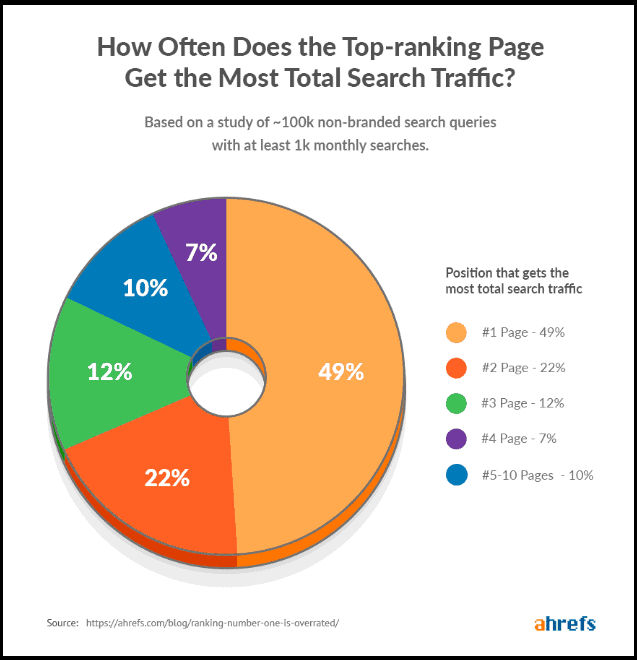
The study shows that ranking number one is overrated.
The lesson here is that you should stop aiming “just” at ranking #1, but work on getting relevant search traffic.
12) Within the first year of publication, only 5.7% of pages will be able to rank among the top 10 search results (Ahrefs)

Ahrefs’ research also revealed that it takes time to rank for competitive keywords.
Only 5.7% of all pages can make it into the top 10 search results within a year of publication.
13) There are more than 200 factors in Google’s algorithm that determine the ranking of websites (Backlinko)

Based on the Backlinko popular article, there are more than 200 ranking factors in Google’s algorithm.
These include things such as page speed, user experience, content quality, and link building.
14) 33.4% of the time, Google changes or edits the title tags (Ahrefs)

Ahrefs’ research showed that out of almost 1 million pages in the study, Google used the original title tags 66,6% of the time.
This percentage is quite different than the 87% usage claimed by Google.
15) High-authority websites are more likely to have a higher ranking on Google’s search results (Backlinko)

The research by Backlinko stated that websites with higher authority (measured using Ahrefs domain rating) tend to have a better ranking in the search results.
16) A quarter (25.02%) of the top-ranking pages do not contain a meta description (Ahrefs)

It may seem obvious, but writing compelling meta descriptions help to increase your organic CTR.
And it’s better to have one, than nothing!
17) Pages with a greater number of backlinks tend to have a higher rank as compared to the ones with fewer backlinks (Backlinko)

And even this statistic seems quite predictable. The interesting data is that, according to the Backlinko-BuzzSumo analysis out of 912 million blog posts, 94% of them do not have any backlinks.
18) Google rewrites meta descriptions 62.78% of the time (Ahrefs)

Ahrefs’ study showed that Big G rewrites meta descriptions 62.78% of the time.
Google uses a number of different sources to automatically determine the appropriate snippet, including descriptive information in the meta description tag for each page. We may also use information found on the page, or create rich results based on markup and content on the page.
19) Using shorter URLs may result in slightly better rankings (Backlinko)
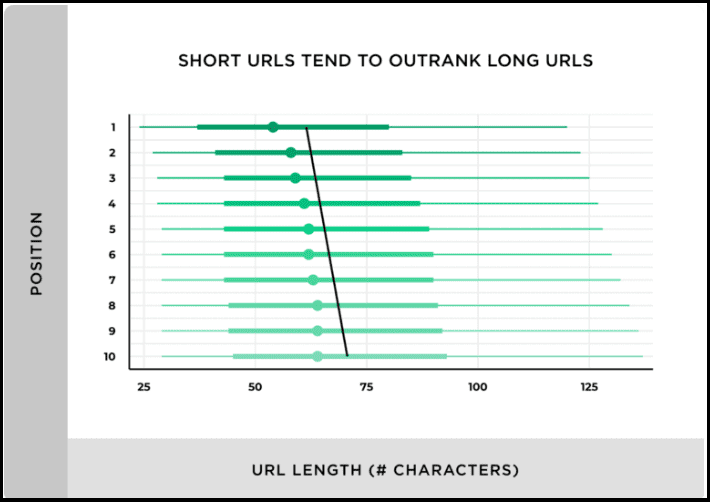
Backlinko’s research revealed that a shorter URL slightly outperforms longer URLs in terms of rankings.
Google suggests writing simple and “not extremely” long URLs.
20) On average, the top-ranking pages usually rank in the top 10 results for around 1,000 other relevant keywords (Ahrefs)

Ahrefs research revealed that if you can rank well for one keyword, chances are you will get good visibility on many other related searches as well.
Lesson: aim for semantic SEO and topic clusters.
21) Websites that have a longer “time on site” generally rank higher on Google (Backlinko)

Based on the study by Backlinko, on average, a website that appears on the first page of Google search results has a time on site of 2.5 minutes (at the moment, mine is around 2.05 minutes).
Google considers user experience signals such as dwell time, bounce rate, and organic CTR to rank content in the SERPs.
Backlink Statistics
Backlinks are one of the main ranking factors in SEO and have been for a long time.
Here are some important link-related stats.
22) On average, the price for purchasing a link is $361.44 (Ahrefs)

Remember that Google is against purchasing or selling links (review the Search Essentials here).
Lesson learned: don’t buy links, earn them!
23) 89.1% of link builders think that nofollow links have an impact on search rankings (AuthorityHacker)

The study by Authority Hacker surveyed over 700 link builders, and the majority of them think that nofollow links have some influence on search rankings.
Google stated that all the link attributes (nofollow, sponsored, or UGC) are used as hints to help them better understand how web pages are interlinked and which links to consider in their system.
24) More than 66% of pages have zero backlinks (Ahrefs)

Is it possible to do SEO without link building?
In some cases, yes.
Discover how in this guide.
25) On average, long-form articles receive 77.2% more links than shorter content (Backlinko)

For example, my keyword research guide (a 3800 words post) gained in one year around 350 backlinks.
26) On average, top-ranking pages get 10 new dofollow links per month (Ahrefs)

It’s called the “vicious circle of SEO“. The theory suggests that top-ranking pages tend to receive more links because people are more likely to link to them.
This leads to a faster accumulation of links compared to other pages on the same topic (that ranks lower in search engine results).
27) Blogging helps companies get 97% more backlinks.
Since 2013, it has been a widespread belief that business sites with blogs get 97% more backlinks.

It may sound obvious, but the more content, the higher the opportunities to acquire new links (and new visitors, or leads).
This confirms the power of blogging in building your website’s domain authority.
28) On average, it takes 3.1 months to see how links affect search rankings (AuthorityHacker)
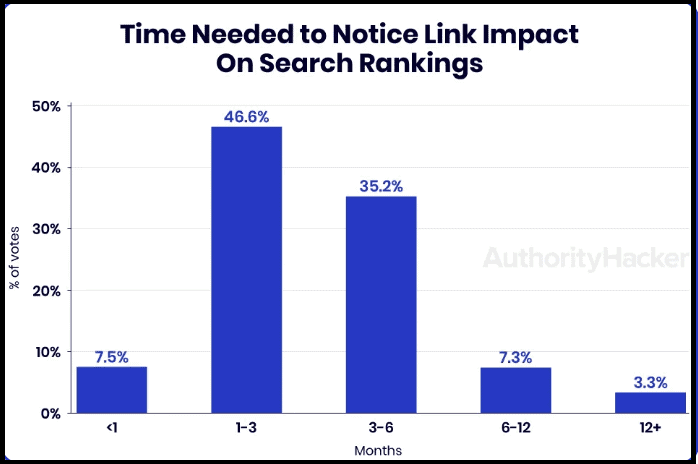
Link building is an ongoing process, and you need to be patient until you start seeing the results.
Since each website is different, it can take a few weeks or months before Google starts taking into account your backlinks in their algorithm.
Key takeaway: focus on quality, not quantity.
Keyword Statistics
Finding easy-to-rank terms have been my favorite SEO strategy to grow niche blogs!
So, let’s see some interesting keyword-related statistics.
29) Almost 95% of keywords have a volume of 10 monthly searches or less (Ahrefs)

Based on Ahrefs U.S. database, 3.8 billion terms get ten monthly searches or fewer.
This means there are still tons of untapped long-tail gems to take advantage of!
30) 8% of search queries are formulated as questions (Moz)

Moz’s research revealed that 8% of all queries contain words such as “what,” “why,” or “how.”
This information is crucial for optimizing content and creating FAQ sections.
31) 50% of the search queries consist of four or more words (Wordstream)

Lesson: focus on writing comprehensive content that covers questions in detail, as well as targeting related terms to increase your chances of ranking more keywords.
32) 15% of all Google searches have never been searched before (Google)
Fun fact: 15% of all Google searches have never been searched before.
— Google (@Google) February 15, 2022
It means there is still a great opportunity to target long-tail keywords!
Lesson: constantly monitor your search engine performance for untapped opportunities.
33) Over 46% of clicks on Google Search Console are hidden terms (Ahrefs)
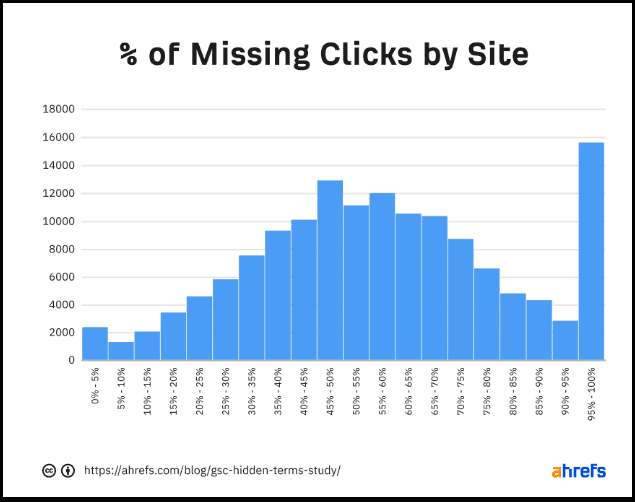
Now you might be wondering, why?
Well, Google stated:
To protect user privacy, the Performance report doesn’t show all data. For example, we might not track some queries that are made a very small number of times or those that contain personal or sensitive information.
What Are the Top 10 Google Searches In The US?
| Ranking | Keyword | US Search Volume |
| =1 | YouTube | 151,000,000 |
| =1 | Amazon | 151,000,000 |
| 3 | 101,000,000 | |
| 4 | 83,100,000 | |
| 5 | Wordle | 68,000,000 |
| =6 | Gmail | 55,600,000 |
| =6 | Weather | 55,600,000 |
| =8 | Google Translate | 45,500,000 |
| =8 | Walmart | 45,500,000 |
| =10 | Yahoo | 37,200,000 |
| =10 | Home Depot | 37,200,000 |
| =10 | Yahoo Mail | 37,200,000 |
| =10 | Translate | 37,200,000 |
Source: ExplodingTopics (June 2023)
SEO Industry Statistics
What is the average cost of SEO services provided by professionals?
Do you have prices that are above or below the average?
Let’s analyze the statistics.
34) Less than $5000 is the monthly amount that most businesses spend on SEO (Sparktoro)

According to the report released by Sparktoro, only 10% of companies invest more than $10,000 on SEO each month.
35) The average SEO annual salary is around $60k/year (Backlinko)

This doesn’t mean that each SEO professional makes this amount of money. It depends on the company, experience, and location.
36) $75–$100 per hour is the most popular pricing for SEOs (Ahrefs)

The numbers vary depending on the location, experience, and type of service.
For example, the rate jumps to $120/hour when the SEOs have been working in the industry for more than 10 years.
37) Global SEO market is expected to reach $122.11 billion by 2028 (Researchandmarkets)

This number is expected to grow despite the current economic situation.
That’s almost double compared to 2020 (when it was $65.25 billion).
38) The top three SEO tools that small businesses use are Google Analytics, Google Search Console, and Answer the Public (Search Engine Journal)

In the third position, there’s also SEOquake, ScreamingFrog, and Majestic.
39) From $2,501 to $5,000 is the most popular per-project SEO pricing tier (Ahrefs)

While 50.6% charge $2,000 or less.
Search Engine Statistics
Search engines are constantly changing their algorithms and introducing new features to keep up with user expectations.
It’s necessary to stay updated with these changes, so let’s see the current trends.
40) About 12.3% of all search queries include a featured snippet (Ahrefs)

During the research, Ahrefs discovered that out of the approximately 112 million keywords in its US database, nearly 14 million had featured snippets in their search engine results page.
41) 34% of search results end with no clicks at all (Moz)

No-click searches, also known as zero-click searches, refer to queries that have all the answers in SERPs.
This means that even though these pages appear in the results, they don’t get any clicks.
42) Top three positions in Google search results get 66.34% of all clicks (Advancedwebranking)

How many times do you scroll the search results to click deep down?
Almost never?
Well, it looks like you are in good company because just the first result gets almost all the clicks, with an organic CTR of 43,43%!
43) Knowledge panels show up in 38% of search results (Moz)

Knowledge panels provide users with additional information on topics, such as places, organizations, and people.
Although they are becoming really popular, people find the information they need, without clicking much on them.
44) 39% of purchasers are influenced by a relevant search (ThinkWithGoogle)

Search engines play an important role in shopping decisions.
Google’s research found that 39% of shoppers look for relevant search results before making a purchase.
45) The top three domains in search results have an average bounce rate of 49% (Semrush)

This means you need to make everything you can to satisfy search intent and improve your bounce rate.
46) More than 99% of featured snippets on Google are already ranked between positions 1 to 10 (Ahrefs)

This means that if you want your content to be featured in a snippet, you need to make sure it ranks in the top 10 first.
47) Google queries that result in pogo-sticking are the 8% (Moz)

Pogo-sticking is the term used to describe when a user clicks on a search result, quickly returns to the SERPs, and then clicks on another one.
You don’t want to be one of them. Instead, work to satisfy search intent!
Local SEO Statistics
Local SEO is becoming more important every day as people are searching online for local businesses.
Let’s see what the data says about it.
49) 30% of all mobile searches are related to location (ThinkWithGoogle)

This means that if you are running a local business, optimizing your content for local searches should be one of your top priorities.
50) 69% of people read online reviews for local businesses (Brightlocal)

Online reviews have become an important part of the shopping process.
If you want your business to stand out, make sure it has plenty of positive testimonials.
51) 76% of people who search on their smartphones for something nearby, visit a business within a day (ThinkWithGoogle)

And 28% of those searches for something nearby result in a purchase.
52) In 2022, 87% of people used Google to research local businesses (Brightlocal)

And this is up from 81% in 2021.
These numbers show how important it is to submit your information to GoogleMyBusiness.
53) People are shopping across Google more than a billion times a day (ThinkWithGoogle)

This comes from the retail marketing guide, posted by Google in March 2022.
54) 48% of consumers say they get inspiration for purchases when they are online (Google)

To gather information on what to buy, people find inspiration on YouTube, browse images, or scroll through Google Discover.
55) 46% of consumers consider online business reviews as trustworthy as personal recommendations of friends or family (Brightlocal)

This data comes from a survey of 2022 (it was 49% in 2021).
56) Searches for “open now near me” have grown globally by over 400% YOY (ThinkWithGoogle)

People want to find what’s available nearby and as fast as possible.
This is why it’s important to make sure your business hours are up-to-date on all of your online listings.
Video SEO Statistics
Video marketing is becoming increasingly important, as more and more people are using YouTube for research purposes.
Let’s take a look at some of the current stats on video SEO.
57) Videos on the first page of YouTube results are around 15 minutes long (Backlinko)

On average, the first result of YouTube is a video of around 17 minutes in length.
58) Videos with many comments tend to rank higher on YouTube (Backlinko)

In general, videos with major engagement rank better. Good signals are the number of likes, shares, view counts, and the number of comments generated.
59) Among the user surveyed, 89% agree that YouTube creators give the best information about products and brands (ThinkWithGoogle)

Other than Google searches, a lot of people look for information on YouTube before making a purchase.
60) The first 10/15 seconds are critical for a video’s success on YouTube (Ahrefs)

In addition to the overall video length, viewers tend to watch only the first few seconds before deciding whether or not they will keep watching it.
Make sure to grab their attention quickly!
61) More than 55% of shoppers say they used online video while actually shopping in a store (Google)

This shows that people are researching products even while in-store, which means that you should optimize your videos for local searches too.
Mobile SEO Statistics
Mobile searches have been growing exponentially in the last few years and this trend is not slowing down.
Let’s look at some stats about mobile SEO.
62) Almost 60% of all website traffic worldwide comes from mobile phones (Statista)
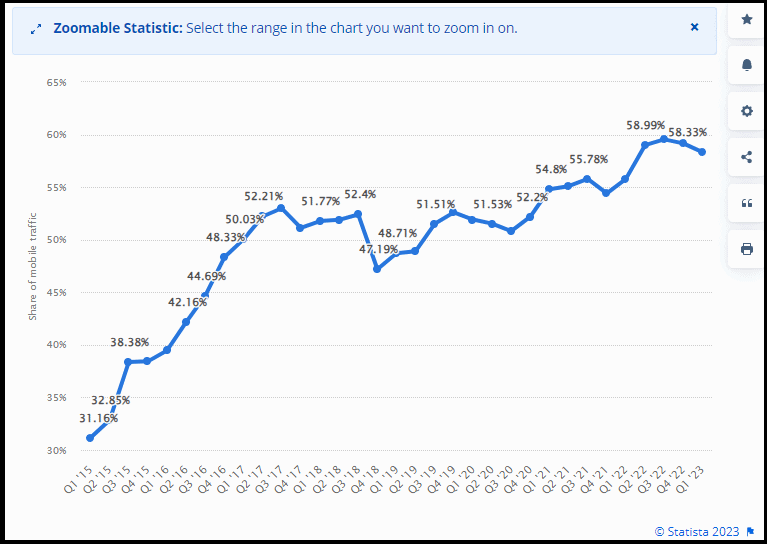
This means that if you want your website to be successful, it must be optimized for mobile.
63) Mobile page loading time is critical: 53% of users will leave a page if it takes more than 3 seconds to load (Google)
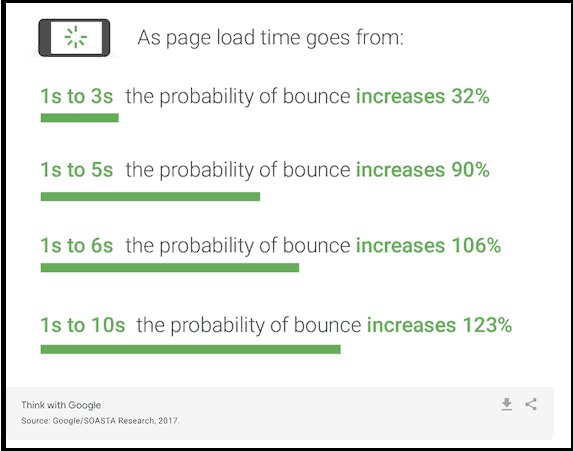
People don’t have the patience to wait for slow pages. Make sure that your website loads quickly on all devices.
63) The first organic result on mobile receives 44,92% of clicks (AdvancedWebRanking)

Data is updated on March 2023.
64) Almost three quarters of internet users will access the web just with smartphones by 2025 (CNBC)

I would not be surprised if the numbers will keep increasing in the next future.
Voice SEO Statistics
Voice search is becoming increasingly popular and it is important to optimize for it if you want your content to be found.
Let’s take a look at some of the current stats.
65) 40.7% of all voice search results are pulled from a featured snippet (Backlinko)

This means that if you want your content to be featured in voice search, it needs to rank in the top 10 for its keyword.
66) 48% of consumers are using voice assistants for web searches (Search Engine Land)

I bet this percentage is expected to increase in the future, so make sure that your content is optimized for voice search.
67) By 2024, there will be 8,4 billion digital voice assistants in use worldwide (Statista)

This number is higher than the current world’s population!
68) Higher rankings increase the chance of being included in voice search results (Backlinko)

It’s not a surprise to me. Higher rankings are directly correlated with good metrics, including topical authority, trust, expertise, and experience (E-E-A-T).
69) The average voice search answer contains only 29 words (Backlinko)

If you want your content to get included in voice search, try following these tips:
- Target Long-Tail Keywords
- Answer Questions
- Create FAQ Pages
- Optimize for Featured Snippets
- Use Natural Language
- Improve Your Site Speed
- Increase Your E.A.T.
- Optimize for “Near Me” Searches
- Improve Content Readability
AI SEO Statistics
Did you know that Google said that is fine to create content with the help of AI tools?
Rewarding high-quality content,
however it is produced
Today, AI is quickly becoming an integral part of SEO and there are plenty of statistics to back this up.
Here are some of them.
70) 80% of Google’s customers are using AI-powered Search ads products (Google)

Google is investing heavily in AI and machine learning, so it’s important to stay updated on their latest technologies.
71) AI’s annual growth rate is expected to be 37.3% from 2023 to 2030 (GrandViewResearch)
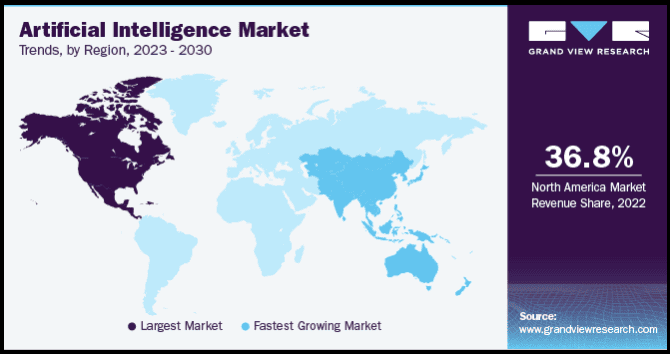
This comes from a report by GrandViewResearch on the AI market in 2023.
72) About 25% of business owners are worried that AI will negatively impact their website traffic (Forbes)

If you ask me, I believe that AI (with Google Bard or its next-generation AI technology) will take a portion of website traffic, by instantly answer to user’s queries.
However, this will only affect a portion of searches. To avoid future pitfalls, focus on building topical authority and E-E-A-T.
73) Use of AI for SEO and content is expected to grow x 5 in 2023 (Search Engine Journal)

AI is expected to be more widely used in SEO and content creation.
It can help automate many of the tasks involved in running an SEO campaign, such as keyword research, link-building, content analysis, etc.
74) 90% of marketers are already using AI tools to help them with different tasks (Hubspot)

AI is already being used in many different aspects of marketing, such as customer segmentation, lead generation, and analytics.
It can also help with content creation by providing insights into what topics are resonating with customers.
75) 84% of bloggers say AI has impacted their SEO strategy for 2023 (Hubspot)

AI can help bloggers improve their SEO efforts by providing insights into what topics are trending, how to optimize content for search engines, and how to create content that is more engaging.
Before You Go
These SEO statistics for 2023 demonstrate the importance of adapting to the ever-changing landscape of search engine optimization.
As AI continues to develop, it’s essential that you stay ahead of the curve and use the latest technologies to your advantage.
Optimize your content, build authority, and focus on providing value in order to rank higher in SERPs.
So, don’t miss to read:
Now, have you found something really interesting among these SEO stats?
What’s your favorite one?
Please let me know in the comments!
And don’t forget to share the post, if you liked it.


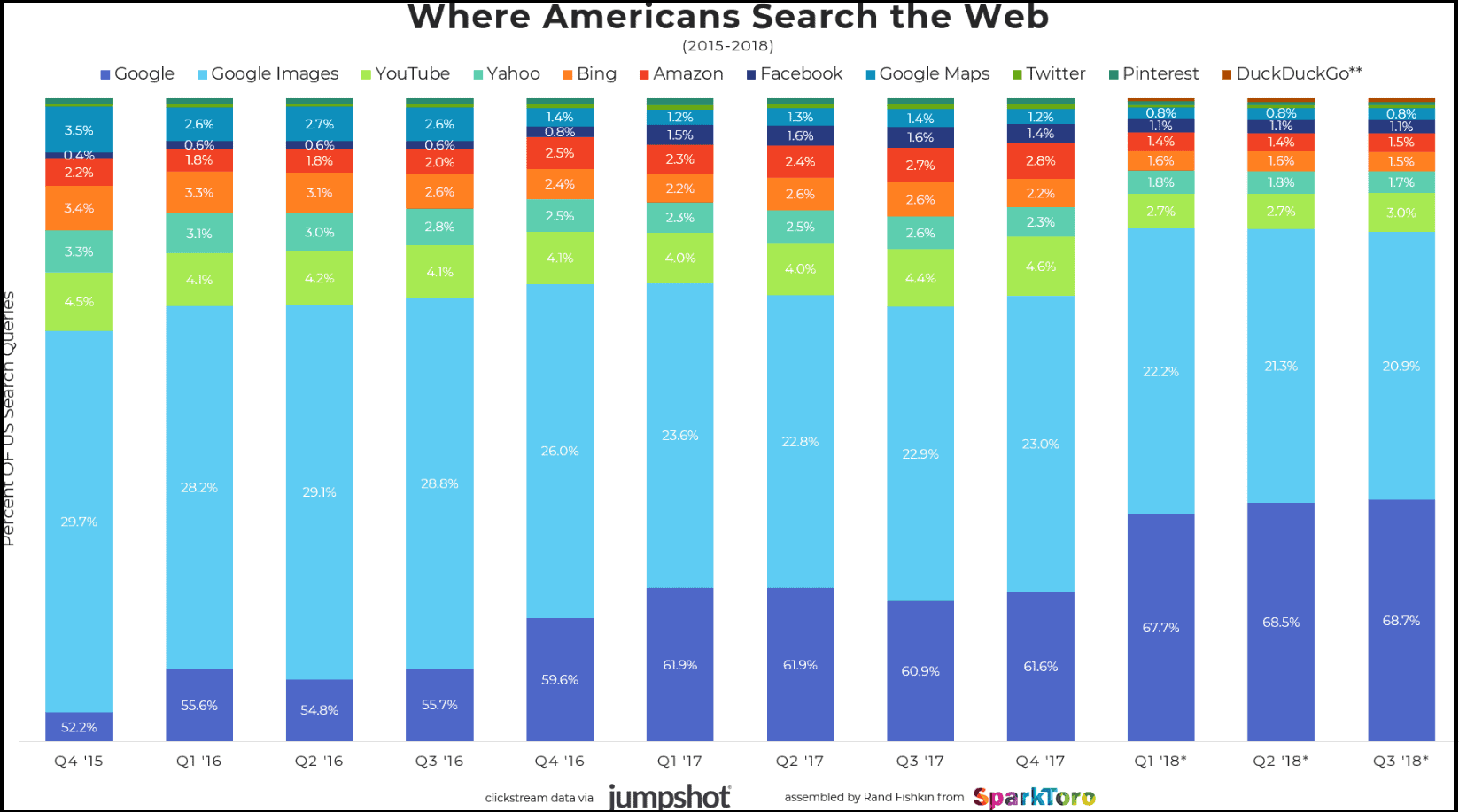
This was a long read but was engaging all through. Looking to work better on my niche sites. Gerard from Texas
Good luck with your niche sites, Gerard. 😉